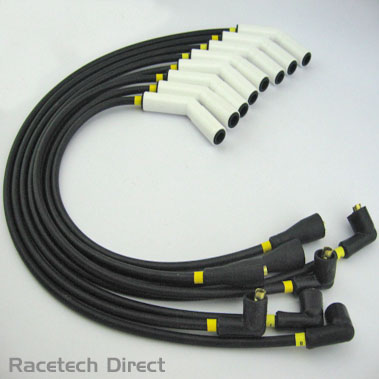Plug extender alternative?
Discussion
swerni said:
I was initially keen to fit a set of these but after reading how difficult they are to remove and of course that combined with their brittle nature can easily result in ceramic fracture. Some suggest lubricating the plug terminal, I guess it would need to be a very high temperature electrical lubricant Sardonicus said:
QBee said:
Be careful and research this. I read somewhere that if you over-insulate the plugs they lose their natural air cooling and can overheat and melt. Could be male round objects, but it made sense at the time. Mine were fine with single socks...
In our case total b ks
ks  you temp probe around that area and you will find no natural air cooling just s
you temp probe around that area and you will find no natural air cooling just s t loads of heat radiated from the ex primaries even when on the move the plugs are recessed anyway and if this was the case plugs 7 & 8 failing would be a regular occurrence due to their restricted thus hotter location its not so I'm calling cods- wallop on this one, we dont hear Chimp-on-gas complaining he is shooting out plugs regular and he has 6 heat range plugs (hotter) thermal socks & hotter burning LPG and clean if not lean AFR's and what about the Turbo brigade running socks ? the ceramic part of the plug is a high temp insulator not an heat sink the ribs are there purely to resist flash over not aid cooling in fact many late plugs no longer have this ribbed part
t loads of heat radiated from the ex primaries even when on the move the plugs are recessed anyway and if this was the case plugs 7 & 8 failing would be a regular occurrence due to their restricted thus hotter location its not so I'm calling cods- wallop on this one, we dont hear Chimp-on-gas complaining he is shooting out plugs regular and he has 6 heat range plugs (hotter) thermal socks & hotter burning LPG and clean if not lean AFR's and what about the Turbo brigade running socks ? the ceramic part of the plug is a high temp insulator not an heat sink the ribs are there purely to resist flash over not aid cooling in fact many late plugs no longer have this ribbed part  wicking away of excess plug heat is taken care of by the water jacket and anything more is down to not matching the plug temp range with the cylinder specs/enviro IMO
wicking away of excess plug heat is taken care of by the water jacket and anything more is down to not matching the plug temp range with the cylinder specs/enviro IMO Edited by Sardonicus on Friday 5th May 10:09
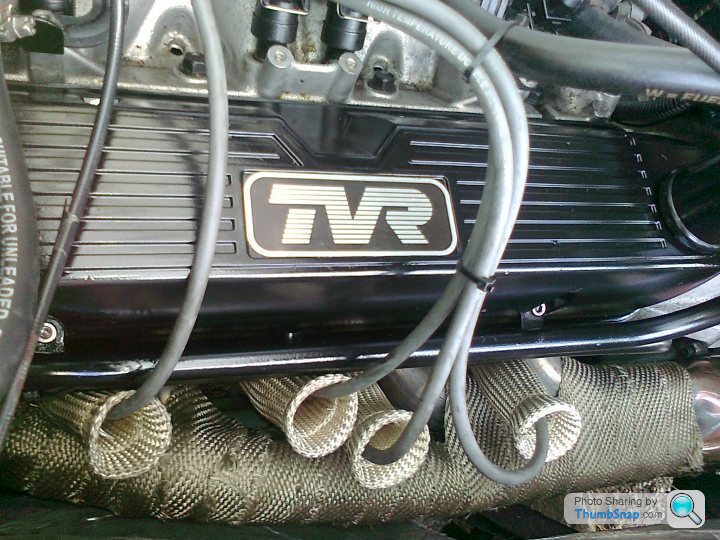
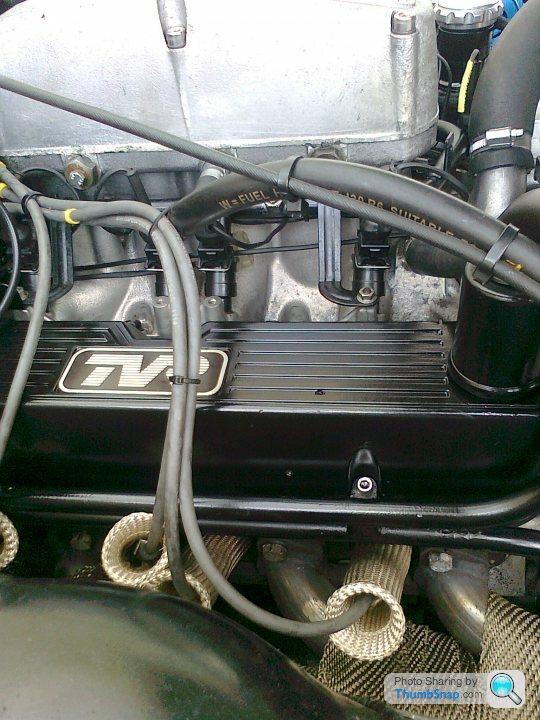

Sardonicus said:
n our case total b ks
ks  you temp probe around that area and you will find no natural air cooling
you temp probe around that area and you will find no natural air cooling
Not trying to open a debate on this subject but that's not right. Thermal effect causes hot gas to rise, arguing that point is futile. Hot gas rises and is replaced. Sure the gas that replaces it is already hot due to being in that vicinity but ultimately any area containing gas that is hotter than its surroundings will experience updraught resulting in gas exchange. Furthermore when the car is in motion the surrounding gas will be cooler which increases the rate of gas exchange due to the greater thermal gradient. That gas exchange sweeps the internal surface of the sock. A physical temperature probe isn't going to show a significant variation and an IR probe will only measure the hard surfaces ks
ks  you temp probe around that area and you will find no natural air cooling
you temp probe around that area and you will find no natural air coolingThat said, the issue here is that some people believe that these thermal insulators are capable of being a permanent thermal barrier when in fact they only slow the rate of thermal transmission. As such, an uncooled system will eventually reach thermal equilibrium, i.e. as hot inside as outside.
bobfather said:
Sardonicus said:
n our case total b ks
ks  you temp probe around that area and you will find no natural air cooling
you temp probe around that area and you will find no natural air cooling
Not trying to open a debate on this subject but that's not right. Thermal effect causes hot gas to rise, arguing that point is futile. Hot gas rises and is replaced. Sure the gas that replaces it is already hot due to being in that vicinity but ultimately any area containing gas that is hotter than its surroundings will experience updraught resulting in gas exchange. Furthermore when the car is in motion the surrounding gas will be cooler which increases the rate of gas exchange due to the greater thermal gradient. That gas exchange sweeps the internal surface of the sock. A physical temperature probe isn't going to show a significant variation and an IR probe will only measure the hard surfaces ks
ks  you temp probe around that area and you will find no natural air cooling
you temp probe around that area and you will find no natural air coolingThat said, the issue here is that some people believe that these thermal insulators are capable of being a permanent thermal barrier when in fact they only slow the rate of thermal transmission. As such, an uncooled system will eventually reach thermal equilibrium, i.e. as hot inside as outside.
 very marginal
very marginal  and Ian N7GTX sensible fella
and Ian N7GTX sensible fella 
I've used titanium heat wrap on the headers right up to the flange plates and forward to the lambda sensors as well as heat socks over the leads (similar to N7GTX). I've also removed precats as well to try to cool down this area down as much as possible - all good so far...I also used UHT matt black paint on the Y-piece in order to shed as much heat as possible in the front of the engine bay - not sure how effective this is but it looks better than the rust look I had previously... 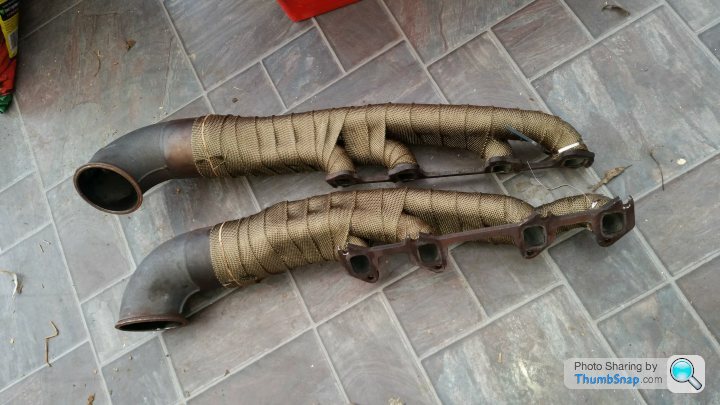

Edited by latham91 on Friday 5th May 15:40
Sardonicus said:
K what I should of said is that cooling is marginal in this area  very marginal
very marginal  and Ian N7GTX sensible fella
and Ian N7GTX sensible fella 
I suspect you're measuring these temperatures with the car not moving and having used many types of temperature probe over the years in the chemical industry I know they only give an indicative result. My issue is only that you implied that there was no air movement, I know for absolute certainty because working with heat processes has been my life for 40 years that gas exchange in this situation is unavoidable. very marginal
very marginal  and Ian N7GTX sensible fella
and Ian N7GTX sensible fella 
As I've said before, the problem isn't whether or not gas is exchanging, it's peoples misunderstanding about how these woven insulations materials work. There are two ways to maintain thermal gradient, firstly to limit the period of exposure, the other is to have a corresponding cooling process to maintain the thermal gradient
Getting into the depths here there is another material property that affects this process that nobody is discussing. The ability of a material to radiate heat alters the rate of heat transfer, Metal is a good radiator of heat whereas these thermal weave products are poor radiators of heat. That is why wrapping the headers works, the heat can't easily radiate to the HT leads. Similarly the loose sock internal surface can't easily radiate to the HT leads
While my double wrapping system is totally proven and LPG destruction tested, as I've already said the best approach is to address the problem at source...
1. Remove your cats
2. Run more advance at idle (anything from 18-26 degrees works perfectly)
3. Enjoy a 50% reduction in manifold heat, a smoother idle, better fuel economy, and noticeably more torque off idle as you pull away
Even if I was still burdened with a distributor I would be looking to switch my vac advance reference from ported vacuum to full manifold vacuum to add 10 degrees at idle. Range Rover only ran the 10-12 degrees as an emissions strategy and make heat, running less advance was adopted in the 70's before catalytic converters were invented because it helps reduce hydrocarbons and oxides of nitrogen.
By the mid 80's catalytic converters started to appear and engine designers realised their earlier reduced timing strategy also helped to light the cats earlier during the warm up phase because running less advance makes a lot more heat in the exhaust manifolds. But these low idle timing settings are not what the engine really wants, idle mixtures are lean so take longer to burn and while the 14.7:1 the 14CUX tries to hit is stoich it is most definitely a very lean idle AFR.
If you look at any Yank V8 from the 60's before all the emissions nonsense started to come in they all ran 20 to 25 degrees at idle using the vac advance capsule plumbed to full manifold vacuum... and for very good reason. The TVR manifold design compounds the problems associated with the heat generating emissions driven ignition strategy, you can get away with it on a Range Rover or Discovery because they have a traditional manifold design but run 10-12 degrees of advance with the forward throw manifolds stuffed with restrictive cats like TVR did and you're only ever going to create a very effective HT lead plug end cooker.
TVR knew this which is why were forced to use the extenders (Vauxhall items if I remember correctly) , these were definitely a work around to solve a problem, a work around that nobody in their right mind would select by choice. The extenders are proven to be an area of failure and unreliability on Chimaeras & Griffs and given they really only exist as a result of running the engine in a way that was specifically designed to create heat you are well advised to tackle to true source of the problem by giving your engine the idle ignition timing it wants.
Having done so you'll not only solve most of the heat issue but you'll also enjoy the other benefits listed above, in summary addressing the problem at source is always preferable to putting a sticking plaster over the symptoms.
1. Remove your cats
2. Run more advance at idle (anything from 18-26 degrees works perfectly)
3. Enjoy a 50% reduction in manifold heat, a smoother idle, better fuel economy, and noticeably more torque off idle as you pull away
Even if I was still burdened with a distributor I would be looking to switch my vac advance reference from ported vacuum to full manifold vacuum to add 10 degrees at idle. Range Rover only ran the 10-12 degrees as an emissions strategy and make heat, running less advance was adopted in the 70's before catalytic converters were invented because it helps reduce hydrocarbons and oxides of nitrogen.
By the mid 80's catalytic converters started to appear and engine designers realised their earlier reduced timing strategy also helped to light the cats earlier during the warm up phase because running less advance makes a lot more heat in the exhaust manifolds. But these low idle timing settings are not what the engine really wants, idle mixtures are lean so take longer to burn and while the 14.7:1 the 14CUX tries to hit is stoich it is most definitely a very lean idle AFR.
If you look at any Yank V8 from the 60's before all the emissions nonsense started to come in they all ran 20 to 25 degrees at idle using the vac advance capsule plumbed to full manifold vacuum... and for very good reason. The TVR manifold design compounds the problems associated with the heat generating emissions driven ignition strategy, you can get away with it on a Range Rover or Discovery because they have a traditional manifold design but run 10-12 degrees of advance with the forward throw manifolds stuffed with restrictive cats like TVR did and you're only ever going to create a very effective HT lead plug end cooker.
TVR knew this which is why were forced to use the extenders (Vauxhall items if I remember correctly) , these were definitely a work around to solve a problem, a work around that nobody in their right mind would select by choice. The extenders are proven to be an area of failure and unreliability on Chimaeras & Griffs and given they really only exist as a result of running the engine in a way that was specifically designed to create heat you are well advised to tackle to true source of the problem by giving your engine the idle ignition timing it wants.
Having done so you'll not only solve most of the heat issue but you'll also enjoy the other benefits listed above, in summary addressing the problem at source is always preferable to putting a sticking plaster over the symptoms.
ChimpOnGas said:
While my double wrapping system is totally proven and LPG destruction tested, as I've already said the best approach is to address the problem at source...
Well put Dave, I know double wrap works, I just trust the technology I've used in industry. Quite right, reducing heat has to be the best way to protect the leads. I would like to go ceramic plug cap so that the heat has nothing to damage but I'm nervous of the removal problems users have experienced. They're flipping expensive, it would be painful if they fractured the first time they were removedGR_TVR said:
Looks nice N7 - what is the exhaust wrapped in and would you recommend it?
 Its titanium heat wrap as others use. I got mine from Demon Tweaks although you can buy it much cheaper elsewhere. So far it seems to be standing up to the job and hasn't dissolved.
Its titanium heat wrap as others use. I got mine from Demon Tweaks although you can buy it much cheaper elsewhere. So far it seems to be standing up to the job and hasn't dissolved.Lots of choice and prices.

http://www.demon-tweeks.co.uk/motorsport/heat-shie...
Edited by N7GTX on Friday 5th May 18:29
bobfather said:
Sardonicus said:
K what I should of said is that cooling is marginal in this area  very marginal
very marginal  and Ian N7GTX sensible fella
and Ian N7GTX sensible fella 
I suspect you're measuring these temperatures with the car not moving and having used many types of temperature probe over the years in the chemical industry I know they only give an indicative result. My issue is only that you implied that there was no air movement, I know for absolute certainty because working with heat processes has been my life for 40 years that gas exchange in this situation is unavoidable. very marginal
very marginal  and Ian N7GTX sensible fella
and Ian N7GTX sensible fella 
As I've said before, the problem isn't whether or not gas is exchanging, it's peoples misunderstanding about how these woven insulations materials work. There are two ways to maintain thermal gradient, firstly to limit the period of exposure, the other is to have a corresponding cooling process to maintain the thermal gradient
 I did this set up years ago it works not really concerned with the in and outs and whys TBH, gives me more time to f
I did this set up years ago it works not really concerned with the in and outs and whys TBH, gives me more time to f k about with better stuff
k about with better stuff  this picture is dated 2010 so that how long I have been using this set up
this picture is dated 2010 so that how long I have been using this set up 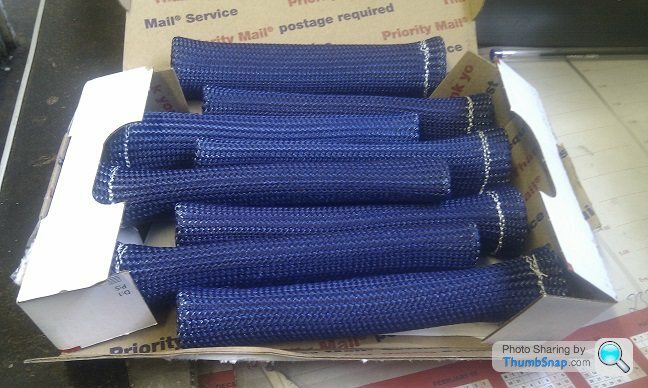
Just to close this off. I've now sorted my shunting issue the cause being a combination of failed plug extenders (thanks for the loan QBee), new ignition amp and a replacement King lead. I've also replaced some more of the ignition system (coil, dizzy cap, rotor arm) and have a new set of leads to fit the weekend so I have a bunch of spares for any European trips.
bobfather said:
I was initially keen to fit a set of these but after reading how difficult they are to remove and of course that combined with their brittle nature can easily result in ceramic fracture. Some suggest lubricating the plug terminal, I guess it would need to be a very high temperature electrical lubricant
I have got some of these myself to put on the chim, any recommendation on what high temp electrical lubricant to use or will any ol stuff off ebay do?cheers
Steve
Dielectric grease is what I've used, just on the rubber section of the accel leads - it's actually an electrical insulator as well as a good moisture barrier.
Had a couple of leads off last night to look at plugs and removing after 1k miles is tight but do-able with a bit of a twisting action. I can see how easy it would be to either break a plug or snap the cermaic lead end...
Had a couple of leads off last night to look at plugs and removing after 1k miles is tight but do-able with a bit of a twisting action. I can see how easy it would be to either break a plug or snap the cermaic lead end...
Gassing Station | Chimaera | Top of Page | What's New | My Stuff




 That previous post wasnt a pop at you by the way
That previous post wasnt a pop at you by the way 

